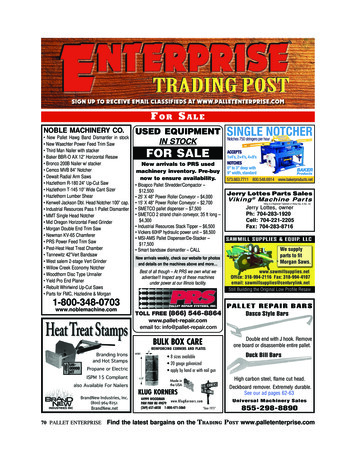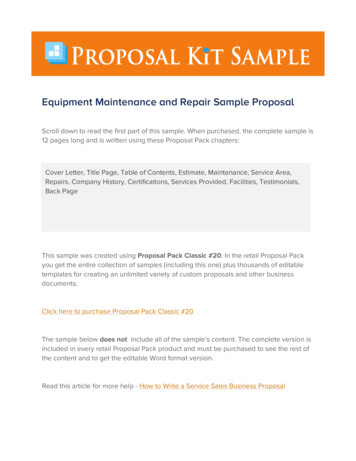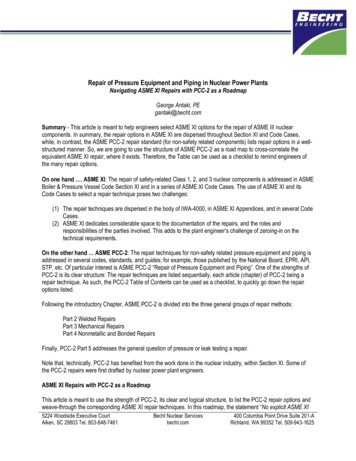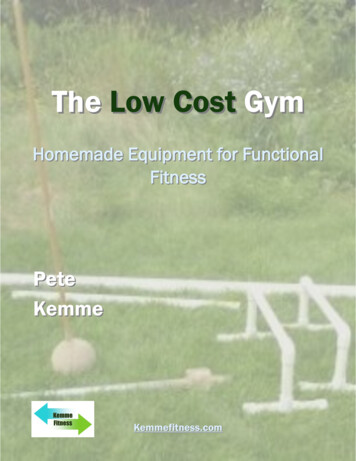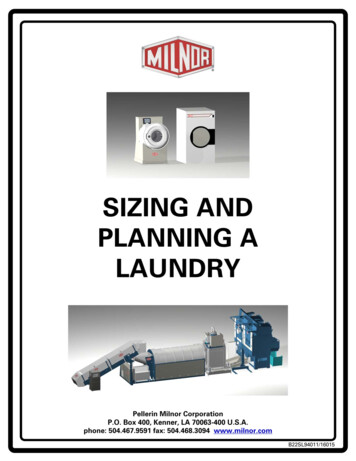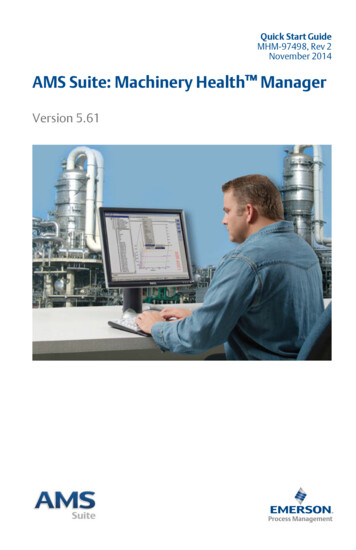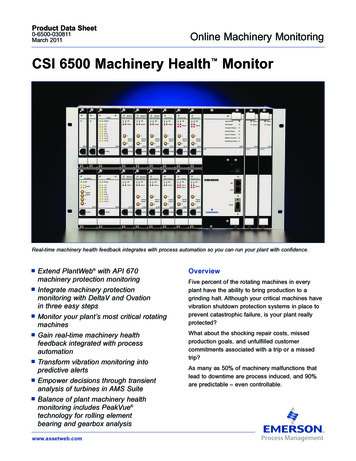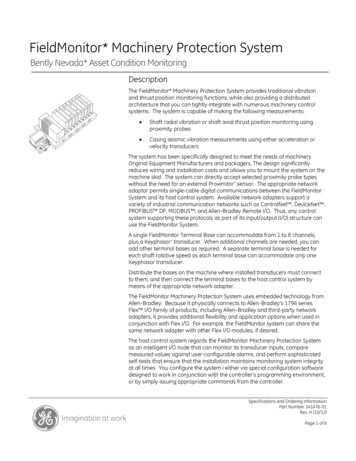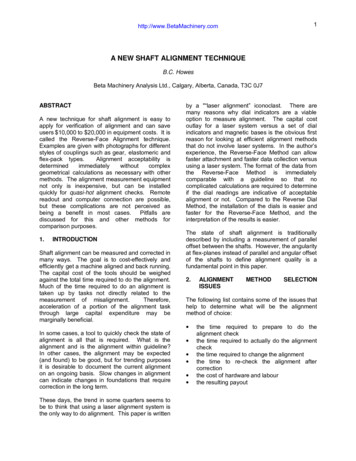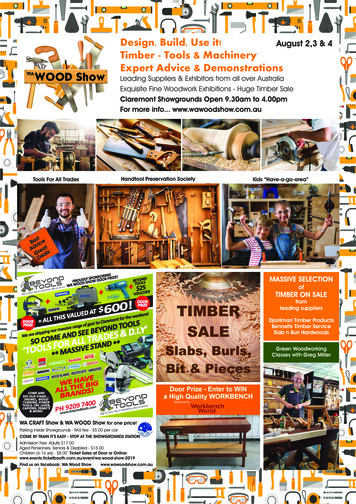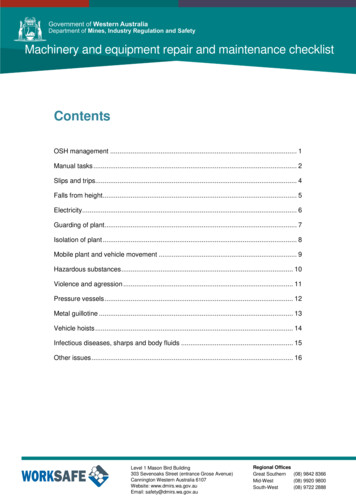
Transcription
Machinery and equipment repair and maintenance checklistContentsOSH management . 1Manual tasks . 2Slips and trips. 4Falls from height. 5Electricity. 6Guarding of plant . 7Isolation of plant . 8Mobile plant and vehicle movement . 9Hazardous substances . 10Violence and agression . 11Pressure vessels . 12Metal guillotine . 13Vehicle hoists . 14Infectious diseases, sharps and body fluids . 15Other issues . 16Level 1 Mason Bird Building303 Sevenoaks Street (entrance Grose Avenue)Cannington Western Australia 6107Website: www.dmirs.wa.gov.auEmail: safety@dmirs.wa.gov.auRegional OfficesGreat Southern(08) 9842 8366Mid-West(08) 9920 9800South-West(08) 9722 2888
OSH managementReport hazards Conduct a riskassessmentConsultationProvide trainingConsultation takes place on OSH matters between management and employees.Hazard and injury reporting: systems are in place for reporting hazards and injuries; reported hazards and injuries have been adequately investigated; and systems are in place for reporting notifiable injuries to WorkSafe.In relation to all tasks: hazards have been identified; the risk of injury has been assessed; control measures have been so far as is practicable implemented; and implemented control measures are regularly reviewed. Safe operating procedures have been developed and implemented. Safety and health representatives have been elected, as per Act.Employees have received adequate safety induction and task specific training in relation to OSH.An OSH management system (eg WorkSafe Plan) has been implemented, including elementssuch as management commitment, safety planning, consultation and reporting, hazardmanagement and training and consultation.Safety and health representatives have been trained, as per Act.An OSH committee is in place.1
Manual tasksIdentify themanual taskshazardsConduct a riskassessmentProvide trainingReport hazardsTrolleys aremaintained Manual task hazards have been identified in consultation with employees. Risk assessments of hazardous manual tasks have been conducted. Risk factors, such ascarrying, pushing, pulling, holding, restraining have been considered. Practicable control measures have been implemented and maintained to eliminate or reducemanual task risk in consultation with employees, such as: altering the workplace environment,design or layout; changing the systems of work; modifying the load being handled; changingthe tools used to do the task or using mechanical aids. Consider: grab rails and adequate steps are in place (three points of contact available); bins on wheels, use of trolley , use of smaller vehicle; limit or avoid double handling of things or items; implement work procedures to limit the manual tasks; trolleys have been provided - no lifting of large or heavy items; wheels of trolleys have been properly maintained and move freely; trolleys are not overloaded when pushing – full visibility is required; work is varied through job rotation or other systems to reduce repetitive actions overlong periods of time, ie sorting at conveyors; adequate mechanical aids has been provided and are used; no lifting of heavy equipment, machinery or recyclable items; no lifting of heavy equipment from one level to another level by stairs; no lifting of heavy equipment from vehicles - lifting equipment is provided; no reaching over work benches and equipment; heavy items are stored at waist height and lighter items are stored at top shelves; access to shelves, storage areas, cupboards is not obstructed; ramps are in place where trolleys are used to go from one level to another level; work benches and other work surfaces are at good height to reduce poor posture; reaching aids, such as hooks, are available where required; adequate and regular breaks are provided to avoid risk of fatigue, which may lead tomuscle and soft tissue injuries, burns, cuts; and well-designed controls and monitors in mobile plant and controls and seat maintained.Task specific induction and refresher training in relation to manual tasks is provided, referto pages 17/18 of the Code of practice Manual tasks or to the manual task training package ofthe WorkSafe website. Elements of training should include: key sections of the OSH regulations and Code of practice Manual tasks; the roles and responsibilities of the employers, employees and others; consultation between the employer and employees in order to identify manual tasks,assess the risk of injury and identify measures to control the risk; basic function of spine, body postures, types of muscle work and principles of levers; the relationship between the human body and the risk of injury; the activities included in manual tasks and resulting types of injuries; risk factors and potential sources of risks; and the control strategies to reduce the risk of manual tasks injuries.2
Manual tasks cont’d Reported manual task injuries and hazards have been investigated the investigation examined the incident details, mechanisms of injury, relevant riskfactors, sources of risks, contributing factors, actions required and practicablecontrol measures to be implemented; and outcomes of the investigation have been reported to the person who reported thehazard or injury within reasonable timeframe; the investigation examined the incident details, mechanisms of injury, relevant riskfactors, sources of risks, contributing factors, actions required and practicablecontrol measures to be implemented; and; outcomes of the investigation have been reported to the person who reported thehazard or injury within reasonable timeframe.For further guidance, refer to the sample template manual task investigation report onwww.worksafe.wa.gov.au. Further information, including a manual tasks toolkit is available fromwww.worksafe.wa.gov.au and includes: Code of practice Manual tasks; Manual tasks training package; Video: Manual tasks risk management - Running time: 11:32 mins; Worksheet: Manual tasks incident investigation (Word); Worksheet: Manual tasks risk management tool (pdf); and Risk management checklist for manual tasks.3
Slips and tripsEnsure the floor isslip resistantPlace warningsign on spillsand wet floorsEradicate tripand fall hazardsGuard rails onramps and stepsAppropriatefootwear is worn Persons can move safety around workplaces - passages are kept free of obstructions. Access to and egress from the workplace is free from obstructions at all times. Emergency egress from the workplace is safe. Ground, floors, stairs or ramps have unbroken and slip resistant surface. Ground, floors, stairs or ramps are free from obstructions or hazards that may cause a personto fall, for instance no electrical leads, hoses, tools, mounted power boxes or water acrosswalkways. In areas where there is a risk of liquid coming into contact with the floor, adequate drainage isprovided. Systems are in place to ensure that the ground or floor is kept free from fall hazards andobstructions. Workplaces are maintained in such clean condition as it necessary to avoid hazards to personsat the workplace – the workplace is kept clean and rubbish is removed. Guard rails or other safeguards are provided on ramps and stairs. Appropriate protective equipment, such as safety boots that complies with Australian StandardAS/NZ2210.1:1994 is provided, where required. Ramps are available in areas where height of floor levels change and trolley access is requiredor items are carried regularly. Steps have even risers and goings, which are not too high or low and have defined nosing andtreads. Guidance is available in the Building Code of Australia Warning signs are available and erected near spills. Safety steps or stepladders are designed appropriately – no standing or sitting on milk crates.4
Falls from heightHazards have beenidentified and risksassessedEdge protection isin place whererequiredProvide trainingand instructionKeep walkwaysfree ofobstructionsLadders complywith AustralianStandards Falls from heights hazards have been identified in consultation with employees.Key areas to check at the workplace include surfaces, levels, structures, the ground, raisedworking areas, scaffolding, edges, hand grips, openings or holes, proximately of employeesto unsafe areas (for instance where loads are placed on elevated areas, where objects arebelow a work area, where work is carried out above workers and where power lines are in theworking area), movement of plant and equipment, access to, egress from and movement inthe working area, manual tasks, lighting, weather conditions, suitability of footwear andclothing, ladders and young or new inexperienced workers. Risk assessments of identified fall from height hazards have been conducted. Practicable control measures have been implemented and maintained to eliminate orreduce falls from heights risk in consultation with employees, for example: safe means of access to and egress from the work at heights is provided; adequate edge protection or a fall injury prevention system (fall arrest system, catchplatform, scaffold, safety nets or safety mesh) is in place in place when:o a person could fall more than 2 metres from a scaffold, fixed stairs, landing,suspended slab, formwork or false work; ando in any other situation where a person could fall 3 or more metres. portable ladders comply with Australian Standard AS 1892.1 1996 (metal) or AS 1892.21992 (wooden) – for work on or near electrical equipment provide appropriate equipment; adequate plant or equipment is provided for the task, for instance an elevated workplatform, a specifically designed industrial lift truck to lift persons into position or aspecifically designed mancage that is securely attached to a forklift (no standing inexcavator bucket or on pallet raised by forklift); stairs, walkways, ladders and mechanical lifts re obstruction free; where items are stored on suspended storage areas or mezzanine floors:o a competent person has conducted a risk assessment to ensure the structuralintegrity of the storage area;o adequate edge protection has been provided; ando the access and egress to and from this storage area is safe. the height of the first step of the vehicle/truck/plant is accessible, width and tread onstep are adequate, grab rails are available and there are three points of contact; for access to top of vehicle/truck/plant a scaffold, portable platform ladder, fall arrestsystem and/or railing on top of vehicle/trucks/plant is installed; no riding on the rear or the side of trucks and plant; and people required to work at height have been provided with adequate information,instruction and training for the work being performed. Anchorage points and fall injury prevention systems Anchorage and fall injury prevention system are of an appropriate design. The fallinjury prevention system and anchorage points must be designed, manufactured,constructed, selected or installed so as to be capable of withstanding the forceapplied to them as a result of a person’s fall.An inspection regime is in place for each component of the fall injury preventionsystem and means of attachment (eg harnesses, safety belts, shock absorbers,lanyards, inertia reels) to an anchorage point.If any signs of wear or weakness are found during the inspection, the components ormeans of attachment are withdrawn from use until they are replaced with properlyfunctioning components.Permanently fixed anchorage points are checked by a competent person inaccordance with the manufacturer’s instructions. If these are not available,anchorage points should be checked by a competent person at least every sixmonths if in regular use or if not regularly used before it is used.5
ElectricityPower tools areRCD protected Electricalinstallations aremaintainedUse molded ortransparentplugsFlexible cords andextensions cordsare used safelyElectrical installations Electrical installations are maintained, protected and tested to minimise the risk ofelectric shock or fire. Evidence of maintenance and testing is in place. Components on the switchboard are clearly labelled. Switchboard is free from obstructions.Residual current devices Hand held portable equipment is protected by RCD. Switchboard or fixed sockets marked whether RCD protected. Testing program in place.Cord, connections, plugs and sockets Flexible cords and extension cords are used in a safe manner. Connections have either a moulded or transparent plug. Plugs, sockets and extension leads are in a good condition and protected fromdamage. Electr
Evidence of maintenance and testing is in place. Components on the switchboard are clearly labelled. Switchboard is free from obstructions. Residual current devices Hand held portable equipment is protected by RCD. Switchboard or fixed sockets marked whether RCD protected. Testing program in File Size: 804KBPage Count: 18
